Table of contents:
What is required for Industry 5.0?
We are on the brink of the 5th industrial revolution. It wasn’t all that long ago that humanity was impressed by the potential of steam power and electricity, and now we are building fully automated robots, smart machines, and networks of smart devices.
The next stage, which some call Industry 5.0, will bring radical innovations in the world of intelligent automation in manufacturing.
Let’s talk about what that will look like.
Industry 5.0 is a stage of development in manufacturing where machines become smart enough to perform complex actions all by themselves, leverage advanced technologies and computing capabilities to collaborate with humans, and work faster and more efficiently.

To understand Industry 5.0 better, we need to examine how manufacturing has developed over the past few centuries.
Industry 1.0 refers to the first industrial revolution. Back in the 18th century, the development of steam power began the mechanization of production.
This led to an increase of up to 8 times in volume and productivity.
Industry 2.0, the second industrial revolution of the late 19th and early 20th century, was triggered by the implementation of electricity in production and the invention of the assembly line.
Henry Ford successfully used assembly line production in his automobile assembly facility, which drastically enhanced the ability to churn out mass numbers of cars.
Industry 3.0 began in the 1970s. The third industrial revolution saw production activities increasingly becoming automated with the help of new memory-programmable controls.
This was the era in which computers became an integral part of production, making possible the partial automation of certain manufacturing processes.
Industry 4.0 is our current state: the application of increasingly sophisticated computers, robots, and communication technologies to industrial processes.
Processes that have been automated and performed by robots are now interconnected with a network of devices that share and analyze data, also known as IoT (Internet of Things) networks.
The whole production line is nearly autonomous; cyber-physical production systems collaborate with people via the network. The only thing missing is advanced intelligence and Data Analytics.
Industry 5.0 fills the gap and adds the missing ingredient — intelligence.
This allows us to blend the power of smart, precise, accurate machinery with human creativity and ingenuity.

The goal of Industry 5.0 is to find the right balance between robotization and humans. But this type of collaboration is already reaping some benefits. We’ll look at those next.
All industrial advancements aim to bring as many benefits as possible while eliminating drawbacks. Industry 5.0 technologies are no exception.
Here are some of the benefits of intelligent process automation.
For example, take a look at FANUC, a company that has been operating a “lights-out” factory for some time already.
A lights-out factory is a plant where machines do all the work. They don’t need lights, air conditioning, heat, or other amenities that are vital for human workers. Even working areas can be optimized for reduced energy use and cost.
Such intelligent automation in manufacturing incorporates effective processes that require fewer resources and less human involvement, helping the business save money.

In manufacturing, there are two main approaches to analyzing and managing process failures caused by the human factor:
Industry 5.0 technologies make it possible to avoid accidents caused by human error. Workers are not involved in the production process at all, or perform only monitoring roles.
An Industry 5.0 plant is a machine-operated factory, with all actions automated. It can even control and analyze what it does by itself, performing far more calculations than a human can.

In addition to obvious environmental benefits, such as less resource consumption and therefore less atmospheric emissions, some other advantages to Industry 5.0 are that it:
Also, Industry 5.0 technologies will help to create “greener” production lines, a high priority in developed countries.

Personalization is best explained with a relevant example.
Industry 4.0 gave the healthcare industry a better means of treating diabetes: today patients can use a special medical device to substitute for a failing pancreas.
This artificial pancreas system, worn externally, regularly checks the diabetic patient’s blood glucose through a skin patch, which communicates wirelessly with an insulin pump that delivers the precise amount of insulin needed.
This is a fully automated solution that nevertheless lacks advanced analysis of a patient’s health condition. Patients with diabetes have different metabolic rates and some other body parameters that are not taken into account by the pancreas substitution.
If we move this solution to Industry 5.0, it will gain intelligence: users will get an app where they can add data about themselves and see analytical data about the pancreas system’s performance.

Applying Artificial Intelligence and Data Analytics technologies, the app will define patterns about how the patient’s body performs and tweak the system so that it becomes more tailor-made for the patient.
It seems that we are ready for Industry 5.0. So let’s take a look at what’s needed to implement it.
Apart from technological progress, here are some things that need to happen during Industry 5.0.
All those disaster movies in which smart robots eventually become evil and destroy humanity display a depressing perspective.
You might think the movie industry is right, and humans should beware of letting robots develop their own intelligence.
But that’s not the right way to look at it.
Andrei Volosyuk
Senior Developer
at HQSoftwareThe objective of Industry 5.0 is to build a fully human-centric solution. Though robots and Artificial Intelligence development will drastically change the workplace and certainly threaten to kill tons of today’s jobs, these technologies should aim at empowering workers rather than replacing them.
In addition to helping people do their jobs better, robots equipped with AI should be able to collaborate.
Robots designed specifically to collaborate with humans have been called “cobots” in terms of Industry 5.0 development.
Cobots are designed to build simple interactions with humans. At the same time, the goal of intelligent process automation is to help cobots set both production goals and industrial-plant safety mechanisms.
Intelligent cobots analyze what human workers do, how they perform, and what objectives they face. The cobots can then replicate these activities, analyze where they can help, and aid operators in their routine.
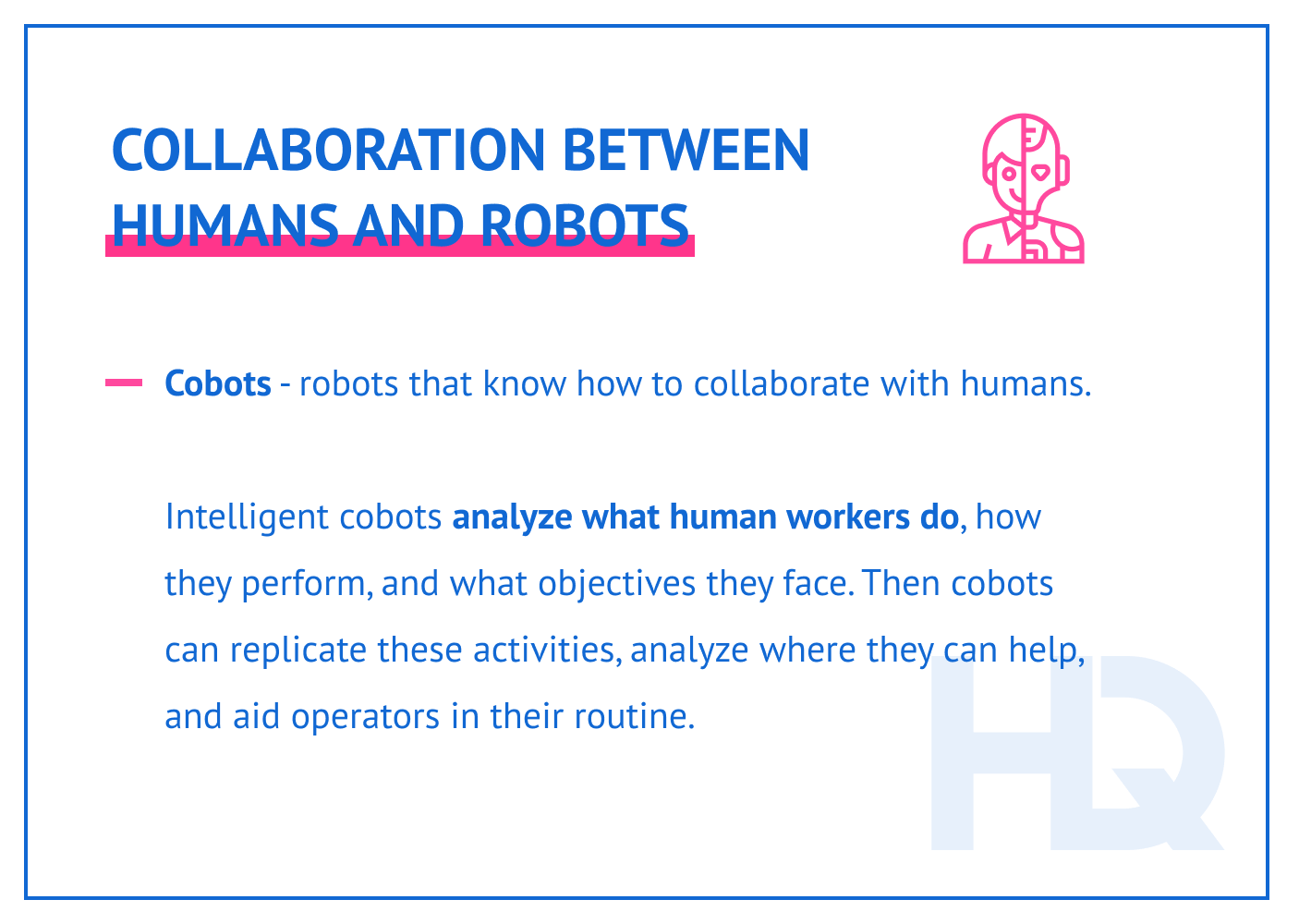
Working in a new environment obviously requires new skills, from creativity to computer knowledge and programming. This environment creates new professions and working positions, such as Chief Robotics Officer.
Businesses that want to take a step forward into the Industry 5.0 era should be ready to invest in personnel training.
One way to cut the cost of staff education and training is to use advanced and technology-wise learning approaches, such as virtual education. That means the production line doesn’t need to stop to allow workers to learn how to operate it, and people in training are not exposed to unnecessary risks in the facility.
Many new jobs will be created in the labor market because of the involvement of robots and AI and the need to control and manage them.
We will guide you through the 5th industrial revolution
You have found your perfect dedicated team here – at HQSoftware, we are ready to share our knowledge on Industry 5.0 solutions.
Julia Tuskal
Head of Sales
at HQSoftware
In a market-driven environment, development in every industry is dependent on how much is invested.
The more businesses, large caps, and investors become interested in Industrial Internet of Things solutions, Artificial Intelligence development, robotics, and everything related to Industry 5.0, the faster the development of this industry will be.
In complex and emerging industries it’s not easy at first to demonstrate ROI, and getting proper financing can be difficult.
Yet business leaders who are interested in intelligent process automation understand that this investment will pay off in ample benefits.
Everything described above is part of the future outlook for Industry 5.0 development.
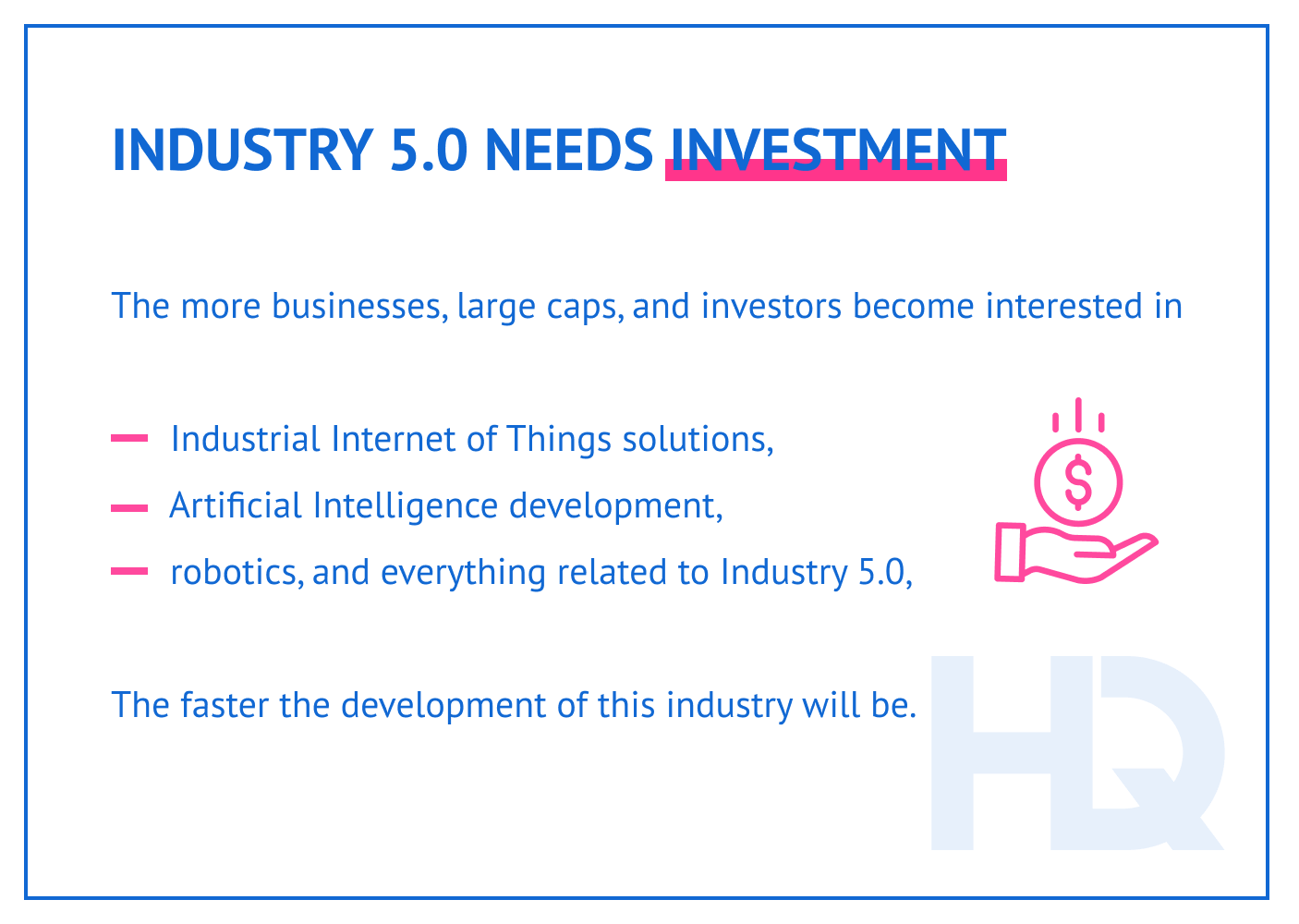
But what’s happening right now?
What follows are some examples of intelligent automation platforms and smart factory solutions already in operation.
Here are some existing “smart factory” solutions, which will only develop further with the expansion of Industry 5.0.
A Digital Twin is a digital representation of an object in the real world, be it a factory, a machine, or a process.
This Industry 5.0 technology allows for testing machines and optimizing the performance of systems without actually interrupting or altering the real thing. All tests and changes are first carried out in a simulation — a Digital Twin.
Industries already using Digital Twins include aerospace, automotive, and heavy machinery. It’s much easier, cheaper, and safer to conduct tests and experiments on online simulations than on real machines or processes.
For example, a race car development team partnered with Siemens to use Digital Twins to help them figure out how to optimize the cars’ performance.
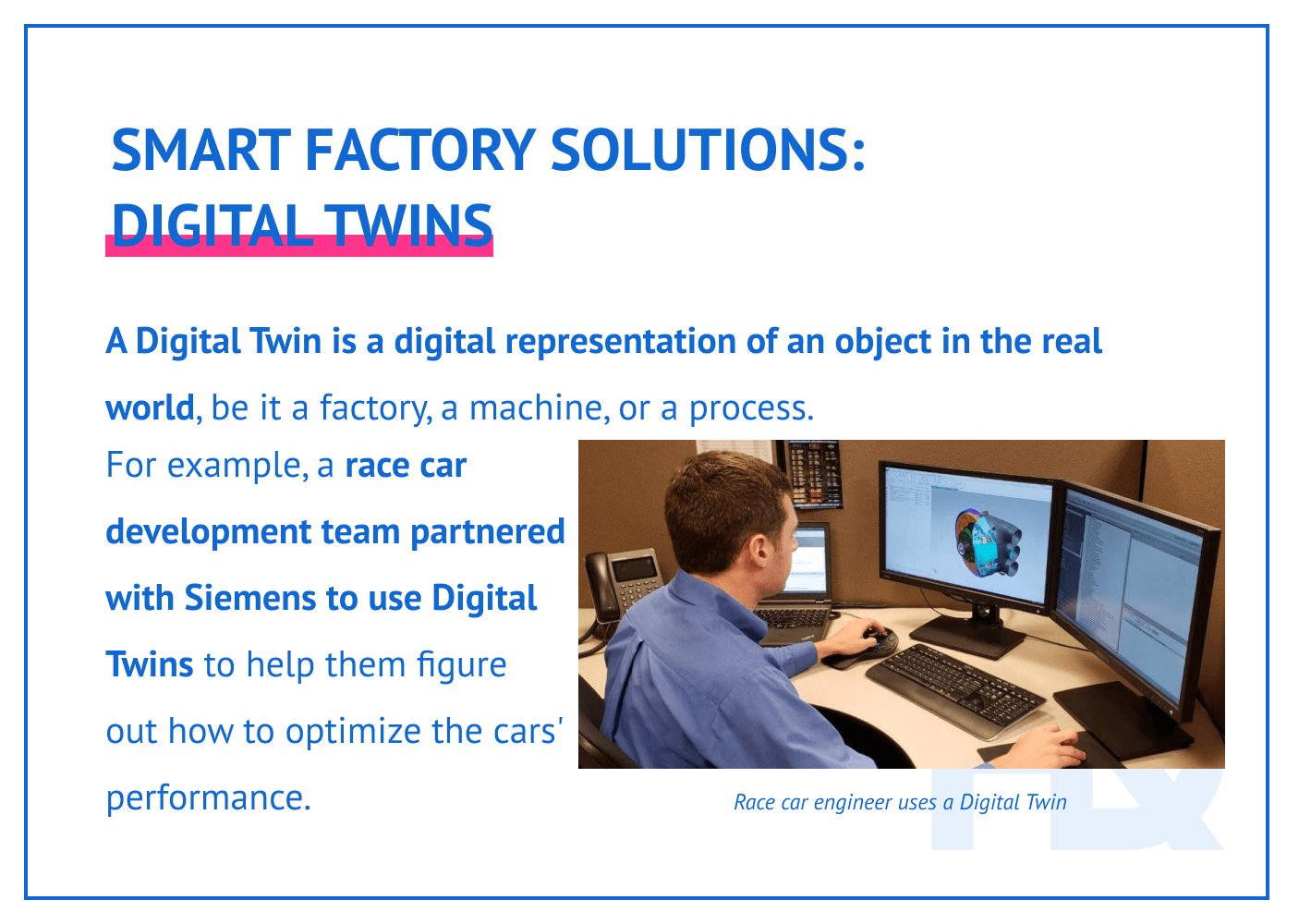
Vehicles that operate without human intervention appear not only on the streets but also at production facilities.
Driverless transport vehicles, or DTV, can transport required components or tools from station to station, choosing the most optimized route by themselves.
The vehicle operates in a sensor-based environment and fetches maps and directions from the cloud. This is how we get a networked logistics solution.
See how Fetch Robotics has applied such a system.
This company has developed Autonomous Mobile Robots that easily operate inside production facilities. They pick objects and transfer them to the required place while moving seamlessly around workers and machines.
With the help of Industry 5.0 technologies, such robots will become even more autonomous, productive, and intelligent.
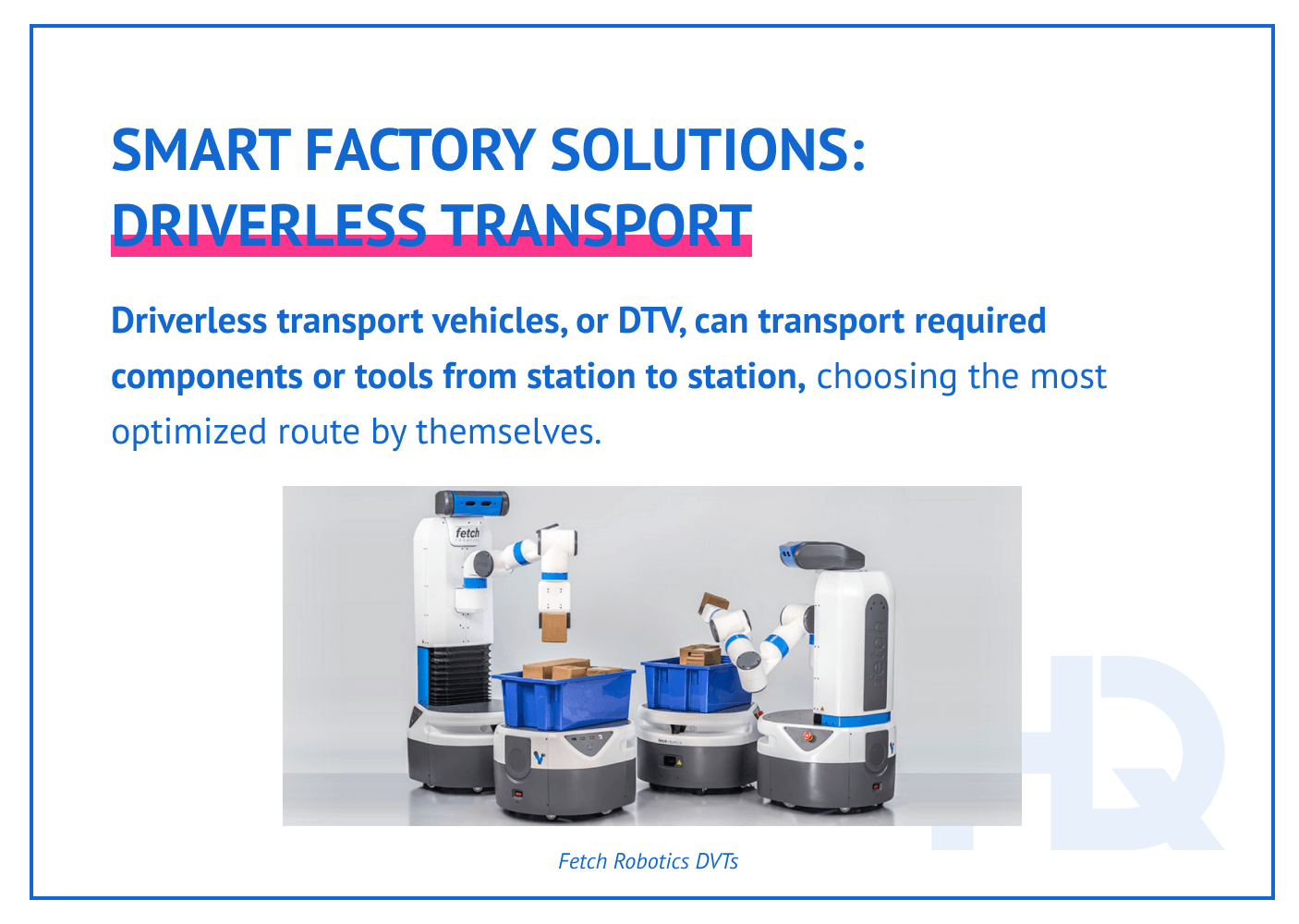
There is huge unrealized potential for AR adoption in manufacturing processes.
Augmented Reality allows for connecting physical and virtual worlds by overlaying data onto a physical object. This requires only simple, affordable devices such as smartphones and tablets to view data.
AR can support other technologies, such as Digital Twins, or act as an independent tool. For example, AR helps with machine maintenance: experiences using AR can show technicians how to perform service on machines in real-time. This is widely applied at General Electric right now.
Another application is in the surgical field.
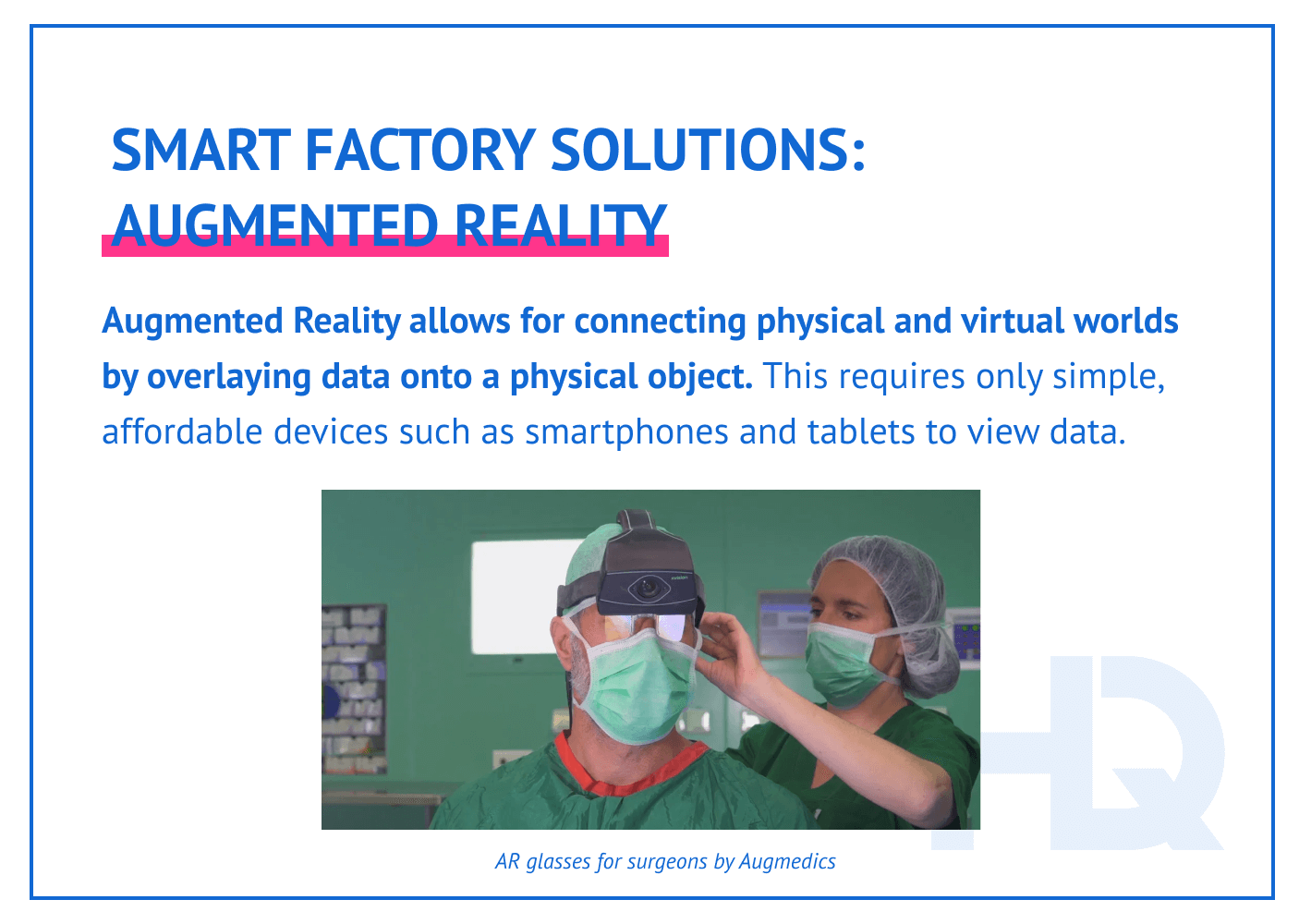
A surgeon can use AR glasses during an operation to see overlaid data from a patient’s profile, such as MRI or blood test results.
Movies about robots and AI taking control over humanity aren’t realistic.
The vector of industry 5.0 development is going the opposite way, toward building a closer relationship between human beings and technology by enhancing the capabilities of both in manufacturing. We at HQSoftware know how to build solutions for the future – just ask for a personal consultation and we will share our knowledge.

Lead Software Engineer
An experienced developer with a passion for IoT. Having participated in more than 20 Internet of Things projects, shares tips and tricks on connected software development.
We are open to seeing your business needs and determining the best solution. Complete this form, and receive a free personalized proposal from your dedicated manager.

Sergei Vardomatski
Founder